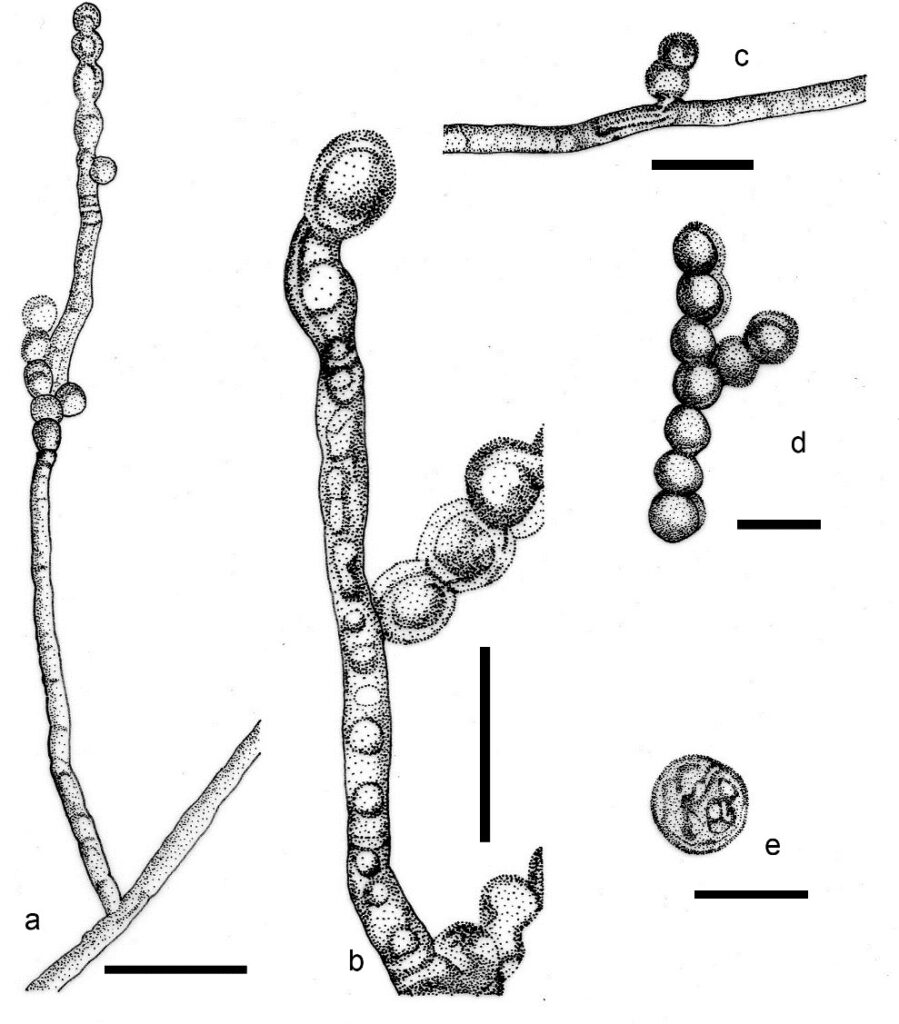Fungalpedia – Note 30 Marinophialophora
Citation: Bhunjun et al. 2023 – Fungalpedia, genera described in 2018, Mycosphere (in press)
Marinophialophora J.F. Li, Phookamsak & K.D. Hyde
Index Fungorum, Facesoffungi, MycoBank, GenBank, Fig. 1
Marinophialophora is a monotypic genus in Herpotrichiellaceae, Chaetothyriales and it is only known from its asexual morph (Li et al. 2018, Tian et al. 2021). This genus was introduced to accommodate a hyphomycetous species that is associated with Halocyphina species (Niaceae, Agaricales) on the intertidal decaying wood of mangroves (Li et al. 2018). Marinophialophora garethjonesii is the type species and this genus is characterized by superficial or immersed, septate, branched, smooth, thin-walled hyaline to subhyaline mycelia on the substrate. Conidiophores arising from hyphae are hyaline to subhyaline, aseptate, thin-walled, smooth, macronematous, mononematous, and straight. Conidiogenous cells are phialidic, terminal or intercalary, globose to ellipsoidal, smooth, and without a conspicuous collarette. Phialoconidia form basipetally and develop unbranched or branched chains, and are hyaline or subhyaline, globose to subglobose, aseptate, and smooth-walled (Li et al. 2018, Tian et al. 2021).
Marinophialophora shows similar morphological characteristics to Cladophialophora, Junctospora, Phialomyces, and Phialophora. However, Cladophialophora differs from Marinophialophora by having holoblastic conidiogenesis. Marinophialophora varies from Junctospora by having intercalary and terminal phialides. Also, Marinophialophora has integrated conidiogenous cells and Phialomyces has discrete conidiogenous cells. Marinophialophora differs from Phialophora in that its phialides lack a prominent collarette, whereas Phialophora has very large and prominent collarettes (Li et al. 2018). The multi-gene phylogeny of ITS, LSU, and SSU placed Marinophialophora within the family Herpotrichiellaceae (Chaetothyriales, Eurotiomycetes), and the type species of Marinophialophora garethjonesii formed an independent lineage basal to the genus Exophiala (Li et al. 2018). The study by Tian et al. (2021) also showed that M. garethjonesii clusters with Atrokylindriopsis setulosa (HMAS245592) in Herpotrichiellaceae with high statistical support in their ITS, LSU phylogenetic tree (Tian et al. 2021). Even though the holotype of this genus was found on the surface of another fungus (Halocyphina sp.), the relationship between this Marinophialophora sp. and Halocyphina sp. is not clear.
Type species: Marinophialophora garethjonesii J.F. Li, Phookamsak, Dayar. & K.D. Hyde
Fig 1. Marinophialophora garethjonesii (KUMCC 16-0066, ex-type) a. Conidia attached to the conidiophore. b, c. Conidiophores with conidiogenous cells. d. Conidia in chain. e. Conidia. Scale bars: a = 10 μm, b–d = 5 μm, e = 2 μm. Redrawn from Li et al. (2018).
References
Li J, Jeewon R, Phookamsak R, Bhat DJ, Mapook A, Chukeatirote E, Hyde KD, Lumyong S, Mckenzie EHC – 2018 Marinophialophora garethjonesii gen. et sp. nov.: a new hyphomycete associated with Halocyphina from marine habitats in Thailand. Phytotaxa 345, 1. https://doi.org/10.11646/phytotaxa.345.1.1
Tian Q, Chomnunti P, Lumyong S, Liu JK, Hyde KD 2021 – Phylogenetic relationships and morphological reappraisal of Chaetothyriales. Mycosphere 12(1), 1157–1261, https://doi.org/10.5943/mycosphere/12/1/15
Entry by
Pranami D. Abeywickrama
Institute of Plant Protection, Beijing Academy of Agriculture & Forestry Sciences, Beijing 100097, P.R China.
Center of Excellence in Fungal Research, Mae Fah Luang University, Chiang Rai, Thailand 57100.
School of Science, Mae Fah Luang University, Chiang Rai, Thailand 57100.
Ruvishika S. Jayawardena
Center of Excellence in Fungal Research, Mae Fah Luang University, Chiang Rai, Thailand 57100.
School of Science, Mae Fah Luang University, Chiang Rai, Thailand 57100.
Edited by
(Edited by Chitrabhanu S. Bhunjun and Kevin D. Hyde)
Published online 23 May 2023
